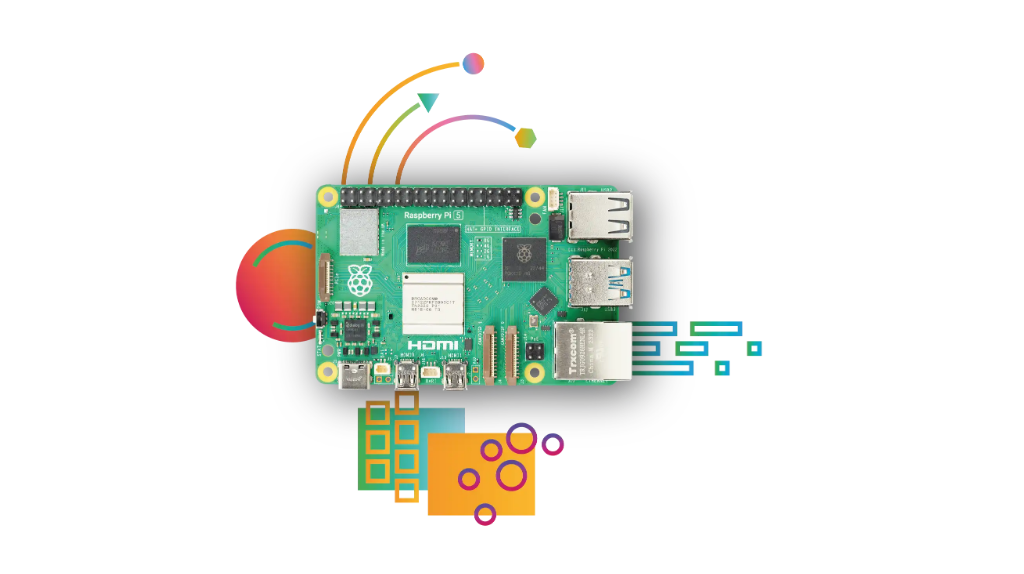Unboxing the powerful Raspberry Pi 5 (Review)! Performance boost, improved RAM, 4K support & more. Learn all about it & see if it's right for you.
Raspberry Pi 5
The Raspberry Pi 5, released in October 2023, the latest iteration of the ever-popular single-board computer (SBC), with much anticipation. Building upon the legacy of its predecessors, the Pi 5 promises enhanced performance, improved capabilities, and continued accessibility for hobbyists, educators, and makers alike. This in-depth review delves into every aspect of the Raspberry Pi 5, analyzing its specifications, features, performance benchmarks, potential uses, and how it compares to the competition. By the end of this comprehensive exploration, you'll have a clear understanding of whether the Raspberry Pi 5 is the ideal device for your next project.
Unboxing the Raspberry Pi 5
The Raspberry Pi 5 retains the familiar credit-card-sized form factor that has become synonymous with the series. The standard package includes the Raspberry Pi 5 board itself, a micro HDMI cable, a power supply (with regional variations), a microSD card (optional), and a basic user manual. Additional components, such as a case, keyboard, mouse, and monitor, are sold separately.
Technical Specifications
Raspberry Pi 5 boasts a significant upgrade from its predecessor, the Raspberry Pi 4. Here's a detailed breakdown of the key technical specifications:
1. Processor
The Raspberry Pi 5 features a Broadcom BCM2837B processor, a quad-core ARM Cortex-A78 clocked at a base frequency of 1.8 GHz (gigahertz). This represents a substantial leap from the Cortex-A72 cores found in the Pi 4, offering improved processing power for demanding applications.
2. RAM
The base model of the Raspberry Pi 5 comes with 4GB of LPDDR4X RAM, a significant upgrade from the 2GB or 4GB LPDDR4 RAM options available in the Pi 4. Higher RAM configurations, such as 8GB and 16GB, are also available for users requiring enhanced multitasking capabilities.
3. Storage
The Raspberry Pi 5 does not include onboard storage. However, it provides a microSD card slot for booting the operating system and storing data. The recommended minimum microSD card capacity is 8GB, but users with extensive storage needs may opt for larger capacities.
4. Video Output
The Raspberry Pi 5 retains the dual micro HDMI ports of its predecessor, supporting resolutions up to 4K at 60Hz. This makes it suitable for multimedia applications and connecting to high-definition displays.
5. Connectivity
The Raspberry Pi 5 offers a plethora of connectivity options, including Gigabit Ethernet, dual USB 3.0 ports, two USB 2.0 ports, a CSI (Camera Serial Interface) port for connecting cameras, and a DSI (Display Serial Interface) port for connecting touchscreens. It also features a standard 3.5mm headphone jack and a GPIO (General Purpose Input/Output) header for interfacing with various electronics components.
6. Wireless Connectivity
The Raspberry Pi 5 comes equipped with integrated Wi-Fi 6 and Bluetooth 5.2, providing faster wireless speeds and improved connectivity range compared to the Wi-Fi 5 and Bluetooth 5.0 found in the Pi 4.
Performance Benchmarks
- Up to 30% improvement in CPU performance.
- Up to 50% improvement in graphical performance.
- Faster boot times and application loading speeds.
- Enhanced multitasking capabilities, especially with higher RAM configurations.
- Media Center: The Pi 5 can effortlessly stream high-definition videos, play music, and function as a central hub for your digital entertainment needs.
- Retro Gaming: With its improved processing power, the Pi 5 can emulate classic video game consoles from various eras, offering a nostalgic gaming experience.
- Robotics and Automation: The GPIO pins and camera capabilities of the Pi 5 make it ideal for building robots, automating tasks, and creating internet-of-things (IoT) projects.
- Education and Learning: The Raspberry Pi 5 is a valuable tool for learning programming, computer science, and electronics fundamentals. Its affordability and ease of use make it a popular choice for educational institutions.
- Web Development and Programming: The Pi 5 can be used as a development platform for web applications and other software projects. It supports various popular programming languages and operating systems.
Software Compatibility
Power Consumption and Cooling
Comparison to Competitors
#1. Rock Pi 5
#2. Orange Pi 5
Advantages and Disadvantages
| Advantages | Disadvantages |
|---|---|
| Significant performance improvement over Raspberry Pi 4 | Higher power consumption compared to Raspberry Pi 4 (requires proper thermal management for demanding tasks) |
| Increased RAM options for enhanced multitasking | Limited onboard storage (relies on microSD cards) |
| Improved connectivity with Wi-Fi 6 and Bluetooth 5.2 | Potential stock shortages due to high demand |
| Dual micro HDMI ports supporting 4K resolution | |
| Affordable price point | |
| Extensive software compatibility | |
| Large and supportive user community |
Who Should Buy the Raspberry Pi 5?
- Hobbyists and Makers: With its improved performance and expanded capabilities, the Pi 5 is ideal for building robots, creating electronics projects, and exploring the world of DIY technology.
- Educators and Students: The Pi 5 serves as a valuable learning tool for programming, computer science, and electronics fundamentals. Its affordability and user-friendly nature make it a popular choice for educational institutions.
- Media Enthusiasts: The Pi 5 can function as a powerful media center, capable of streaming high-definition content, playing music, and managing digital media libraries.
- Gamers: The Pi 5 excels at emulating retro video game consoles, offering a nostalgic gaming experience for enthusiasts.
- Developers and Programmers: The Pi 5 can be used as a development platform for web applications, creating prototypes, and exploring various programming languages.
Getting Started with Raspberry Pi 5
- Purchase: Once you've secured a Raspberry Pi 5 board, ensure you have the necessary accessories, including a power supply (with the correct plug type for your region), a microSD card with a minimum capacity of 8GB (preferably pre-loaded with an operating system like Raspberry Pi OS), a case to protect the board, and peripherals like a keyboard, mouse, and monitor.
- Setting Up the Hardware: Carefully assemble your Raspberry Pi 5 by attaching the heatsink or fan (if using), inserting the microSD card, and connecting the power supply and peripherals. Refer to the official Raspberry Pi documentation or online tutorials for detailed assembly instructions.
- Powering On: Connect the Raspberry Pi 5 to your monitor and power it on. The boot process should begin, displaying information on the screen.
- Operating System: If your microSD card is pre-loaded with an operating system, it will automatically launch upon boot. If not, you'll need to download the desired operating system from the Raspberry Pi website and flash it onto your microSD card using a computer. There are various tools available for flashing operating systems, and the Raspberry Pi Foundation provides clear instructions for this process.
- Configuration: Once the operating system is booted, you may need to go through some initial configuration steps, such as setting up Wi-Fi, creating a user account, and adjusting settings according to your preferences.



COMMENTS